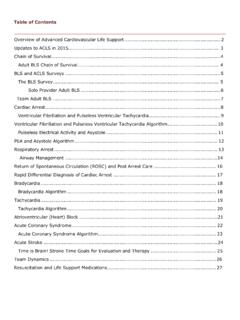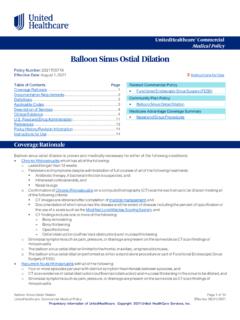Transcription of Neonatal Resuscitation - National CPR Association
1 Neonatal Resuscitation A Life-Saving Guide for Newborns Co nte nts Neonatal Resuscitation : An Overview ..2 Transitioning from Fetus to Neonate ..2 Normal Transition: A Birth ..2 Problems with Transition ..3 Predicting the Need for Resuscitation ..3 Neonatal Assessment ..4 The Apgar score ..4 The Apgar score Is Not Used to Direct Resuscitation ..5 Assessing the Need for Neonatal Resuscitation ..5 Staying with the Mother ..6 Further Evaluation ..6 Pulse Oximetry ..6 Neonatal Resuscitation Techniques ..7 Supplemental Positive Pressure Ventilation ..8 Positive Pressure Ventilation with Bag-Mask Devices ..8 Effective Positive Pressure Ventilation ..9 Laryngeal Mask Airway ..9 Intubation .. 10 Chest Compressions .. 11 Epinephrine .. 11 Volume Expansion .. 11 Resuscitation Tools .. 12 Factors That May Complicate Resuscitation .. 12 Airway Obstructions .. 12 Choanal 12 Robin Syndrome .. 12 Pulmonary Complications.
2 1 Impaired Respiratory Drive ..1 Cardiac Abnormalities ..1 Post- Resuscitation Care ..2 Resuscitating Preterm Babies ..3 Ethical Considerations ..4 References ..5 Neonat al Re suscita tio n: An Ov erv ie w Nine out of ten neonates successfully transition from fetus to newborn. Unfortunately, the remaining 10% of neonates require assistance from medical providers. Less than 10% of these newborn babies (approximately 1% overall) will require Neonatal Resuscitation . On the other hand, almost one-quarter of Neonatal deaths occur because of birth asphyxia, according to the medical journal The Lancet (Lawn, Cousens, & Zupan, 2005). Therefore, practitioners who are adept at Neonatal Resuscitation can save the lives of newborn babies. Tra nsi tio ni ng from Fet us to N eonat e Normal Transition: A Birth The transition from fetus to neonate, commonly called birth, is one of the most profound changes that human will ever undergo.
3 During this transition, the fetus ceases to receive blood, oxygen, and nutrients from the maternal circulation and must derive those things from the outside world. Before birth, the neonate s lungs and gastrointestinal system are not functional. The neonate s lungs, once filled with amniotic and fetal lung fluid in utero, become filled with air upon birth. The neonate s circulatory system must change from one that receives blood flow through the umbilicus, to a closed system driven by his own heart. In other words, the newborn baby must begin to breathe on its own and his heart must pump blood to his body. The blood will then circulate to the gastrointestinal system, as it will throughout his life. In utero, the fetus lungs are filled with amniotic fluid and fetal lung fluid. The blood vessels surrounding the alveoli of the fetal lung are constricted, with little blood flow.
4 When the fetus is born, fluid within the lungs is rapidly absorbed as oxygen fills the lungs. At this time, blood flow increases in the lungs so that oxygen can be readily absorbed and then distributed to the rest of the body. For blood flow to increase, a few things must Problems with Transition As with any complex biological process, sometimes things can go wrong. The transition from fetal to Neonatal life may not occur smoothly. Any one (or more) of the things that must change during the transition may not actually change. Perhaps the neonate has air in the lungs, but the blood vessels surrounding the alveoli do not relax. Thus, the newborn is ventilated but the circulatory system is not receiving oxygen through the alveoli. This is a problem of the pulmonary circulation. The circulatory system may not transition from fetal to neonate; the problem is with the systemic circulation.
5 The most common cause of problems with transition, however, occurs from problems with pulmonary ventilation. Despite the neonate's efforts, the newborn's lungs do not fill with air and remain full of amniotic/fetal fluid. The newborn will attempt to preserve blood flow to the heart and brain as much as possible, but sustained problems with transition will lead to brain damage, myocardial infarction, and/or death. If anything goes wrong in the transition from receiving oxygen via the placenta to receiving oxygen from the lungs, the baby s ventilation will be compromised. In this case, a couple of things could happen: 1) The baby could attempt to breathe and then endure primary apnea. The reduced heart rate that occurs in this situation can be reversed with tactile stimulation. 2) With secondary apnea, the heart rate continues to drop, and blood pressure decreases as well.
6 In this case, assisted ventilation must be employed because tactile stimulation is not enough to help the baby recover. Predicting the Need for Resuscitation There are some clues that can indicate that a baby may require Resuscitation . We have already seen that babies born prematurely are at higher risk for requiring Resuscitation . Babies born to obese mothers have also been shown to be at higher risk for requiring ventilation (Khalak, Cummings, & Dexter, 2015). Muscle tone is another indicator of health related to ventilation. With good muscle tone, the extremities are flexed, whereas flaccid extremities can indicate poor ventilation. The following table includes factors that increase the risk of a difficult child birth. Mother Fetus/Neonate Peri-partum <16 years or >40 years of age Prematurity or Postmaturity Prolapsed cord Lower socioeconomic status Macrosomia Utero-placental bleeding Smoking, alcohol/drug abuse Intrauterine growth retardation Breech presentation Chronic/untreated medical conditions ( , diabetes, preeclampsia) Multiple gestation Chorioamnionitis Worrisome obstetric/gestational issues ( , PROM, placenta previa) Congenital anomalies Meconium-stained amniotic fluid PROM = Premature rupture of membranes Neonat al A sse ssme nt The Apgar score The Apgar score is a standardized score that provides information on the condition of the baby when the baby is born.
7 The score quantifies 5 key factors: color, heart rate, reflex irritability, muscle tone, and respiration. Each factor is given a score of 0, 1, or 2. A 0 indicates a problem, a 2 indicates normal, healthy activity and a score of 1 indicates an intermediate state, neither healthy nor completely problematic. The 5 scores at each time interval are added for a total Apgar score . Apgar scores are routinely assessed at 1 and 5 minutes after birth. If the Apgar score is below 7 at 5 minutes after birth, then the scores should be taken again at 10 minutes, 15 minutes, and 20 minutes after birth. A score 7 or above is normal, while a score below 7 indicates distress. A 5-minute Apgar score at or below 3 strongly suggests that Neonatal death is imminent (Iliodromiti, mackay , Smith, Pell, & Nelson, 2014). Despite this, Apgar scores are not used to direct Resuscitation efforts.
8 They simply provide a measure of the neonate s health status. To calculate heart rate, count the number of heartbeats that occur in 6 seconds. Because one minute is 10 times more than 6 seconds, you can multiple the number of heartbeats that occur in 6 seconds by 10 to determine the beats per minute (often referred to as bpm), which is the standard metric for heart rate. Acceptable stimuli are drying the baby and suctioning the airway, which will be sufficient to stimulate most neonates. If these do not elicit a response, one may try flicking in the feet and/or rubbing the baby s back. Do not stimulate the baby too vigorously and never shake a baby. Do not spend too long trying to induce a response through stimulation. Instead, focus on other interventions. The Apgar score Is Not Used to Direct Resuscitation The Apgar score is a virtually universal instrument to assess newborn health and viability.
9 You may wonder why it is not used to direct Resuscitation efforts in neonates. The reason is simple: Neonatal Resuscitation , for those who need it, must begin before the first assignment of an Apgar score . While 60 seconds after birth does not seem like a long time, every second matters in Neonatal Resuscitation . Instead of Apgar score , healthcare professionals will focus on three factors at the time of birth: airway, breathing, and circulation. While adult Resuscitation guidelines have moved to CAB, Neonatal Resuscitation still follows the ABCs because most neonates who need Resuscitation require airway and breathing support, and less often circulatory support. The reverse is true in adults. Assessing the Need for Neonatal Resuscitation The initial assessment of every newborn baby, performed at the moment of birth, includes three questions: 1.
10 Is the baby born at term? 2. Is the baby breathing/crying? 3. Does the baby have good muscle tone? If the answer to all three of these questions is yes, the baby may stay with the mother. If the answer to any of these 3 questions is no, proceed to further evaluation. Staying with the Mother Staying with the mother does not necessarily mean placing the baby and the mother's arms immediately. Every neonate requires a few steps before initial mother child bonding can occur. 1. Warm the baby To reduce any further heat loss, dry the baby and remove any wet linens. The baby may be put under a radiant warmer to reduce heat loss, but not be put under towels or blankets. Monitor the baby s temperature to ensure that the baby does not overheat. 2. Open the baby s airway Put the baby in the sniffing position on its back or side, and be careful not to extend the neck too much or too little.






